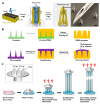Engineering Microneedles for Therapy and Diagnosis: A Survey
- PMID: 32150866
- PMCID: PMC7143426
- DOI: 10.3390/mi11030271
Engineering Microneedles for Therapy and Diagnosis: A Survey
Abstract
Microneedle (MN) technology is a rising star in the point-of-care (POC) field, which has gained increasing attention from scientists and clinics. MN-based POC devices show great potential for detecting various analytes of clinical interests and transdermal drug delivery in a minimally invasive manner owing to MNs' micro-size sharp tips and ease of use. This review aims to go through the recent achievements in MN-based devices by investigating the selection of materials, fabrication techniques, classification, and application, respectively. We further highlight critical aspects of MN platforms for transdermal biofluids extraction, diagnosis, and drug delivery assisted disease therapy. Moreover, multifunctional MNs for stimulus-responsive drug delivery systems were discussed, which show incredible potential for accurate and efficient disease treatment in dynamic environments for a long period of time. In addition, we also discuss the remaining challenges and emerging trend of MN-based POC devices from the bench to the bedside.
Keywords: diagnosis; drug delivery; microneedle; point of care.
Conflict of interest statement
The authors declare no conflict of interest.
Figures








Similar articles
-
Advances and challenges in developing smart, multifunctional microneedles for biomedical applications.Biotechnol Bioeng. 2022 Oct;119(10):2715-2730. doi: 10.1002/bit.28186. Epub 2022 Aug 5. Biotechnol Bioeng. 2022. PMID: 35854645 Review.
-
Microneedles for transdermal diagnostics: Recent advances and new horizons.Biomaterials. 2020 Feb;232:119740. doi: 10.1016/j.biomaterials.2019.119740. Epub 2019 Dec 26. Biomaterials. 2020. PMID: 31918227 Free PMC article. Review.
-
The Role of 3D Printing Technology in Microengineering of Microneedles.Small. 2022 May;18(18):e2106392. doi: 10.1002/smll.202106392. Epub 2022 Mar 31. Small. 2022. PMID: 35362226 Review.
-
Exploring new frontiers in drug delivery with minimally invasive microneedles: fabrication techniques, biomedical applications, and regulatory aspects.Expert Opin Drug Deliv. 2023 Jun;20(6):739-755. doi: 10.1080/17425247.2023.2201494. Epub 2023 Apr 12. Expert Opin Drug Deliv. 2023. PMID: 37038271
-
3D printed microneedles for transdermal drug delivery: A brief review of two decades.Int J Pharm. 2021 Mar 15;597:120301. doi: 10.1016/j.ijpharm.2021.120301. Epub 2021 Feb 1. Int J Pharm. 2021. PMID: 33540018 Review.
Cited by
-
Poly(2-Hydroxyethyl Methacrylate) Hydrogel-Based Microneedles for Metformin Release.Glob Chall. 2023 Jul 5;7(8):2300002. doi: 10.1002/gch2.202300002. eCollection 2023 Aug. Glob Chall. 2023. PMID: 37635699 Free PMC article.
-
Therapeutic Potential of Microneedle Assisted Drug Delivery for Wound Healing: Current State of the Art, Challenges, and Future Perspective.AAPS PharmSciTech. 2025 Jan 8;26(1):25. doi: 10.1208/s12249-024-03017-z. AAPS PharmSciTech. 2025. PMID: 39779610 Review.
-
A Perspective on Imiquimod Microneedles for Treating Warts.Pharmaceutics. 2021 Apr 22;13(5):607. doi: 10.3390/pharmaceutics13050607. Pharmaceutics. 2021. PMID: 33922157 Free PMC article.
-
Recent advancements in the expedition of microneedles: from lab worktops to diagnostic care centers.Mikrochim Acta. 2023 Jul 18;190(8):301. doi: 10.1007/s00604-023-05859-z. Mikrochim Acta. 2023. PMID: 37464230 Review.
-
Bright Semiconductor Quantum Dots Shed New Light on Precision Nanomedicine for Various Diseases.Small Sci. 2023 Nov 27;4(1):2300081. doi: 10.1002/smsc.202300081. eCollection 2024 Jan. Small Sci. 2023. PMID: 40212631 Free PMC article.
References
-
- Razmi N., Hasanzadeh M. Current advancement on diagnosis of ovarian cancer using biosensing of CA 125 biomarker: Analytical approaches. TrAC Trends Anal. Chem. 2018;108:1–12. doi: 10.1016/j.trac.2018.08.017. - DOI
-
- Shafiee A., Ghadiri E., Kassis J., Pourhabibi Zarandi N., Atala A. Biosensing Technologies for Medical Applications, Manufacturing, and Regenerative Medicine. Curr. Stem Cell Rep. 2018;4:105–115. doi: 10.1007/s40778-018-0123-y. - DOI
-
- Markets and Markets. Wearable Medical Devices Market by Device (Diagnostic (Heart, Pulse, BP, Sleep), Therapeutic (Pain, Insulin, Rehabilitation)), Application (Sport, Fitness, RPM), Type (Smartwatch, Patch), Distribution Channel (Pharmacy, Online) - Global Forecast to 2022. [(accessed on 1 March 2020)]; Available online: https://www.marketsandmarkets.com/Market-Reports/wearable-medical-device....
Publication types
Grants and funding
LinkOut - more resources
Full Text Sources
Other Literature Sources

